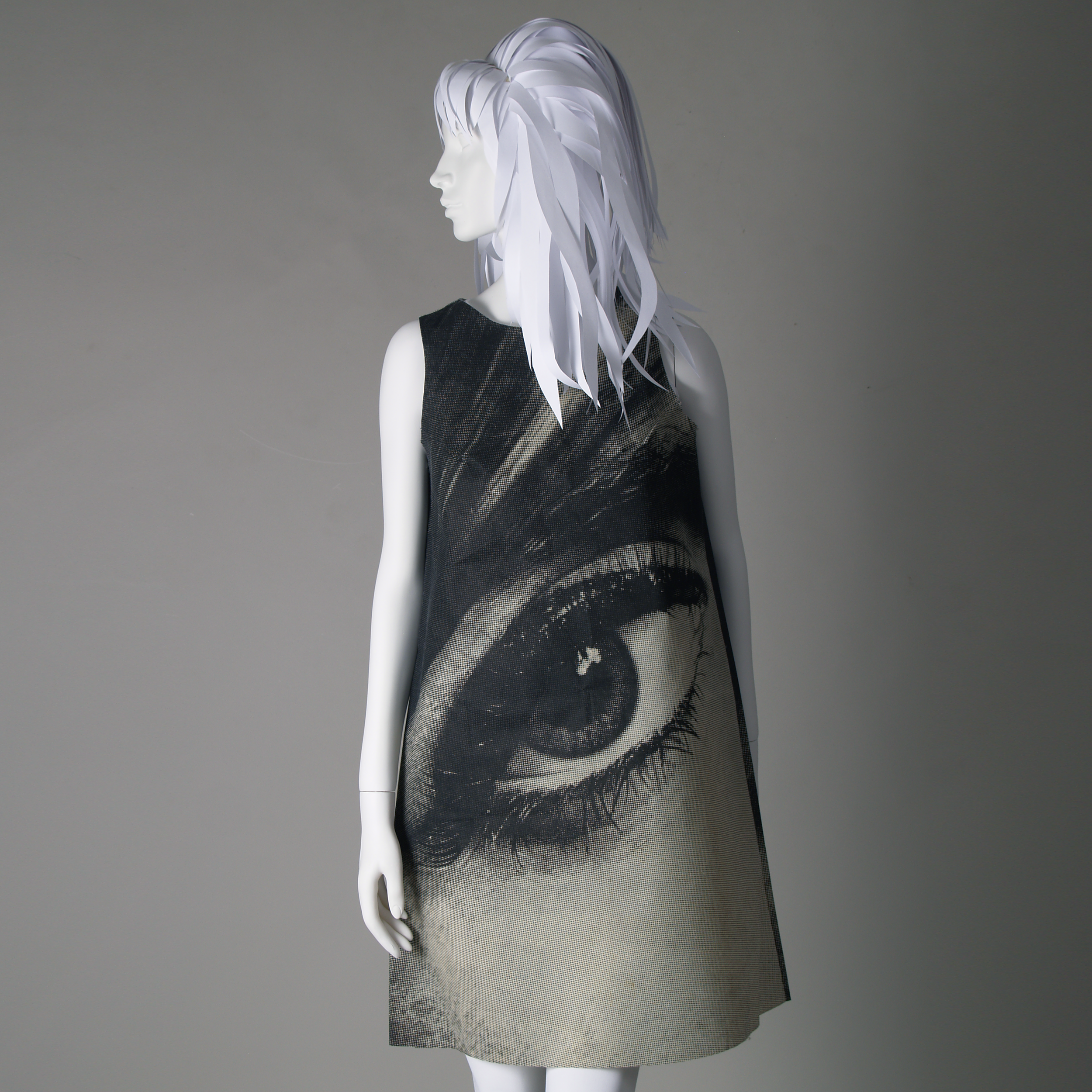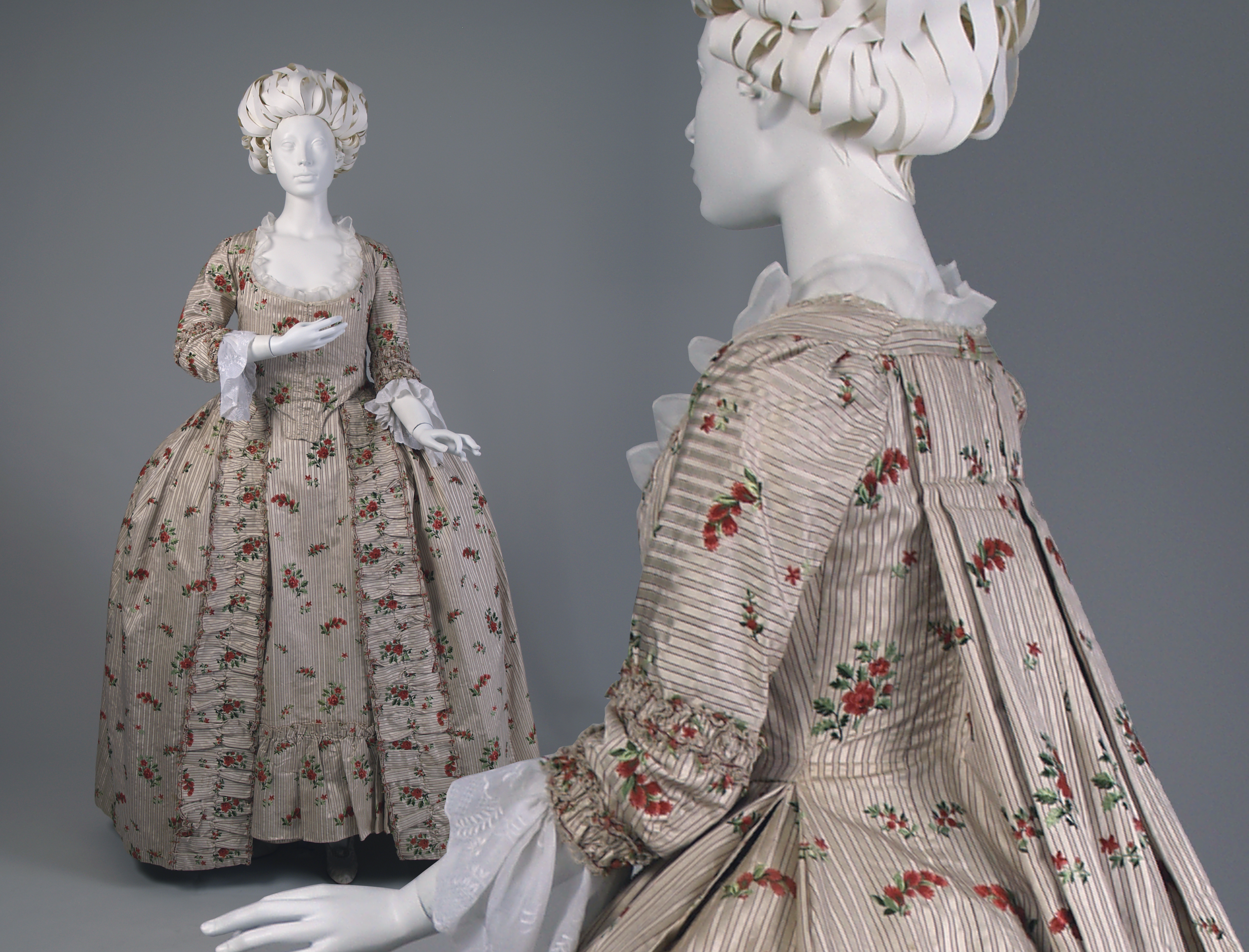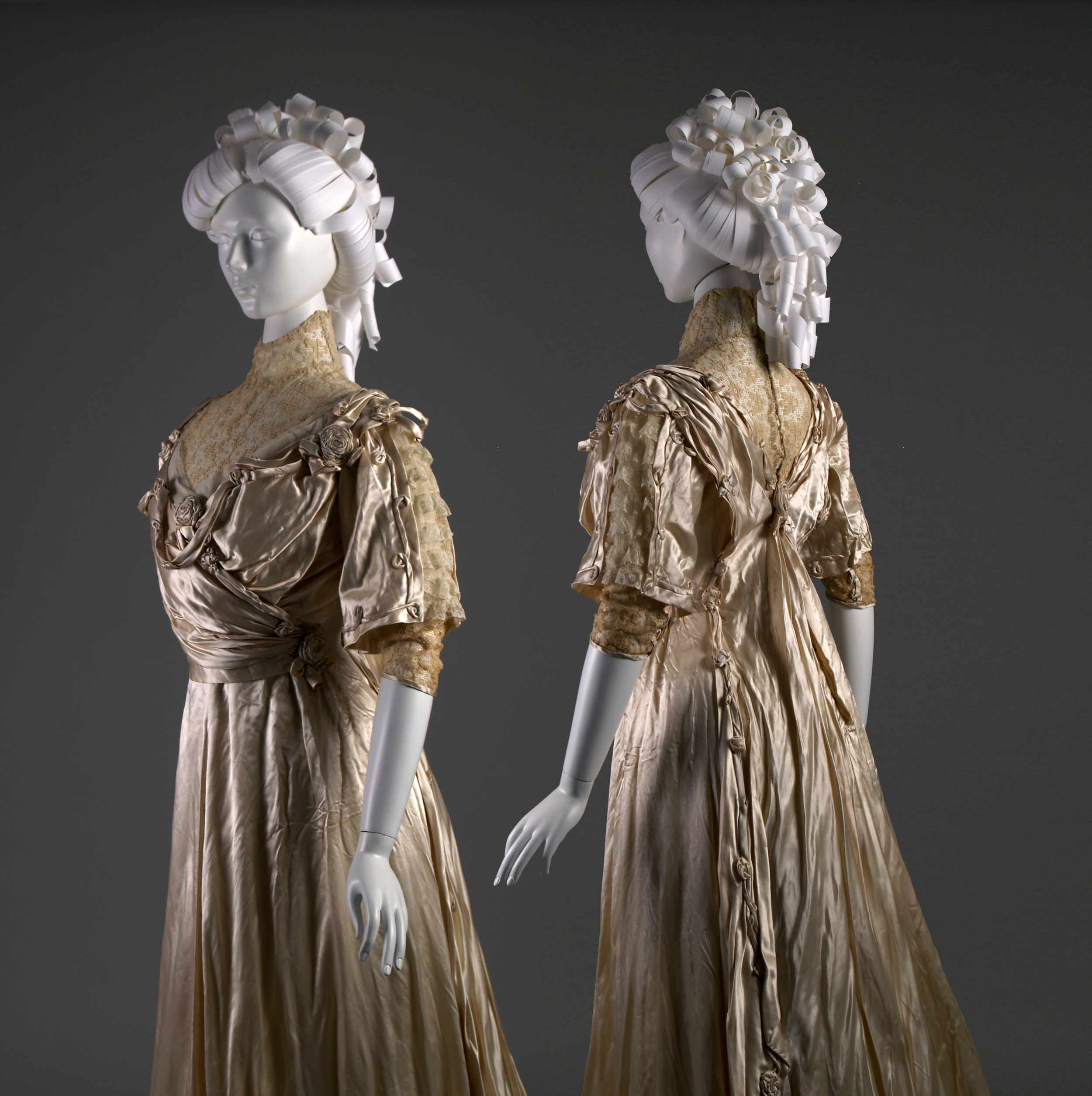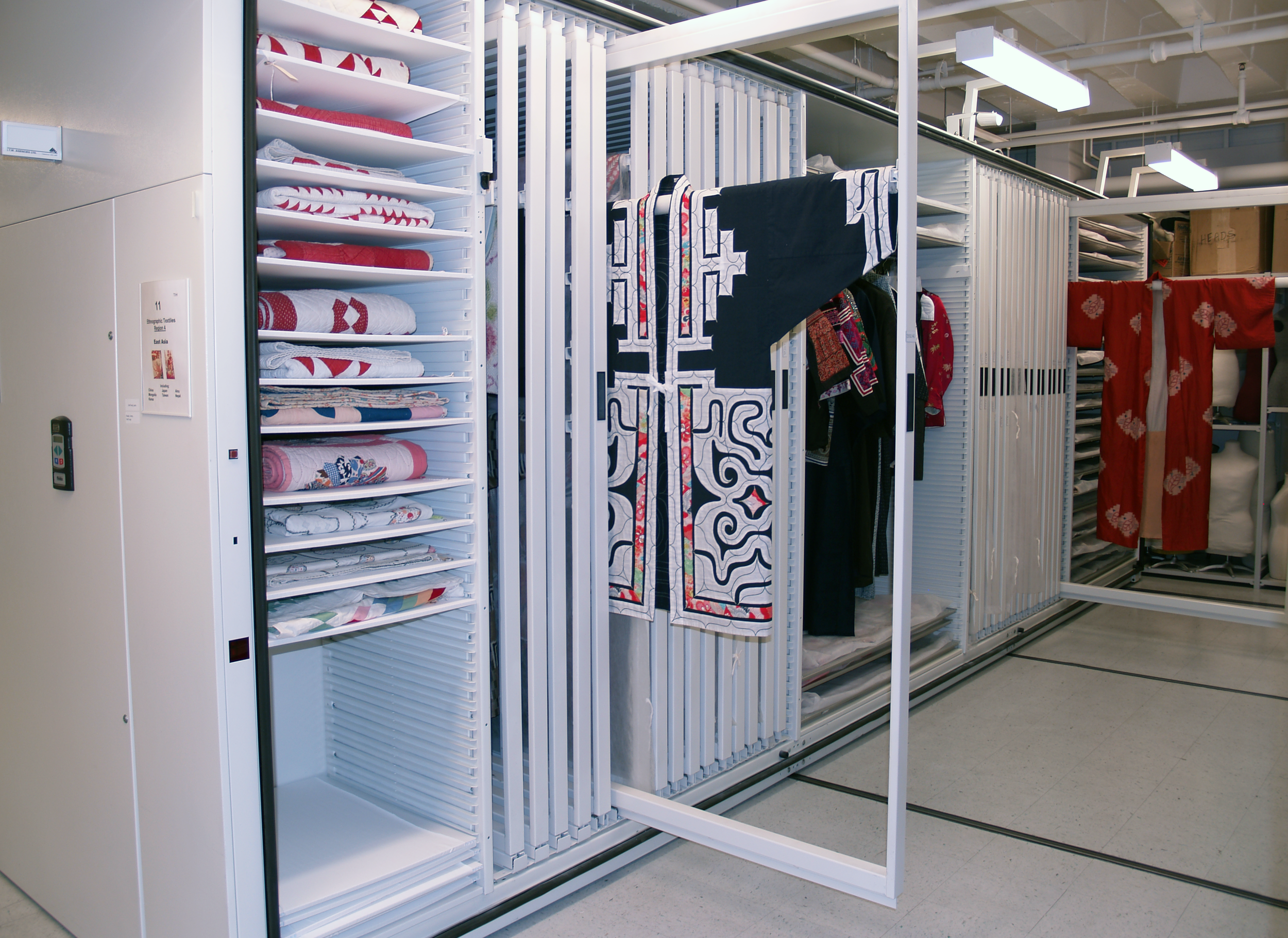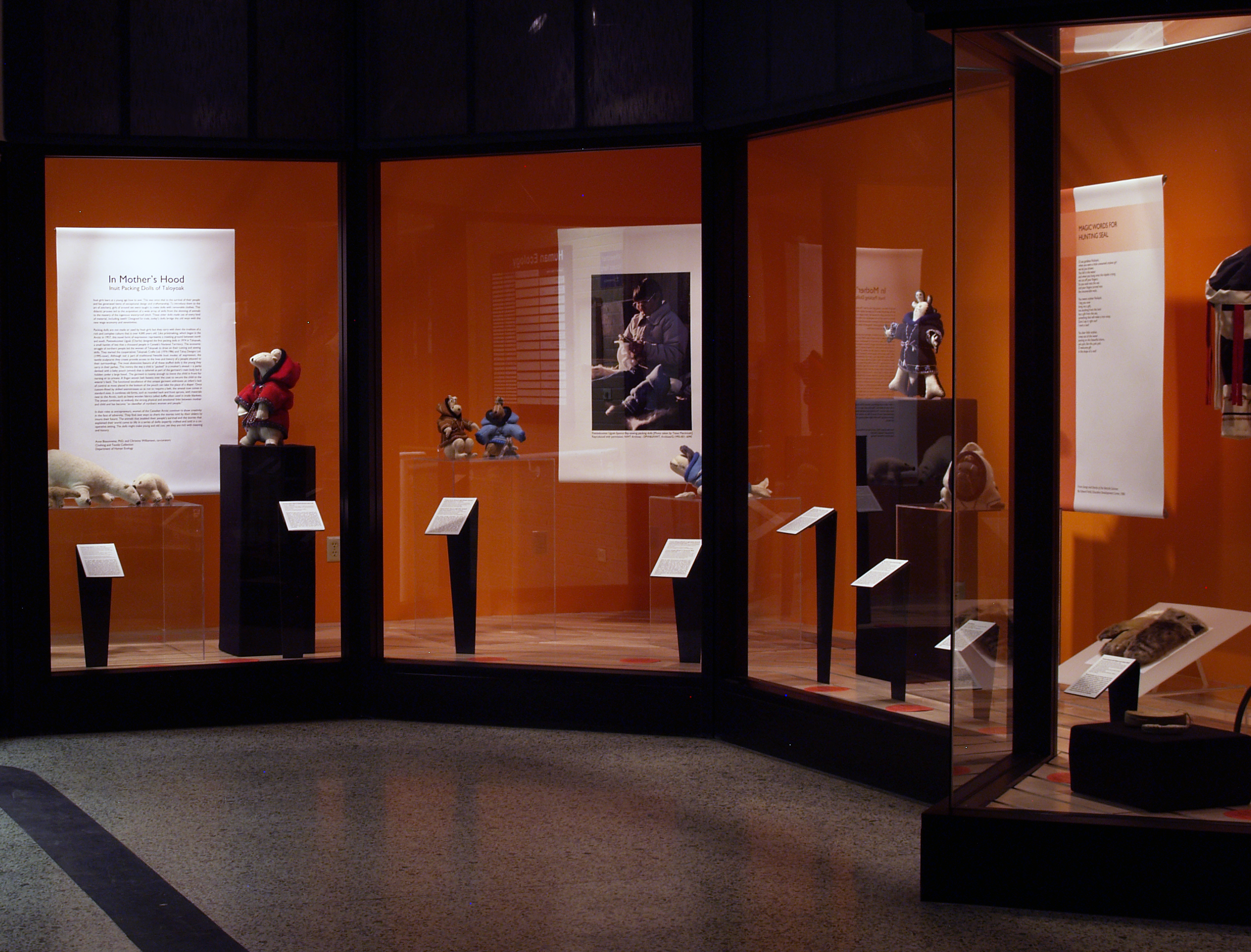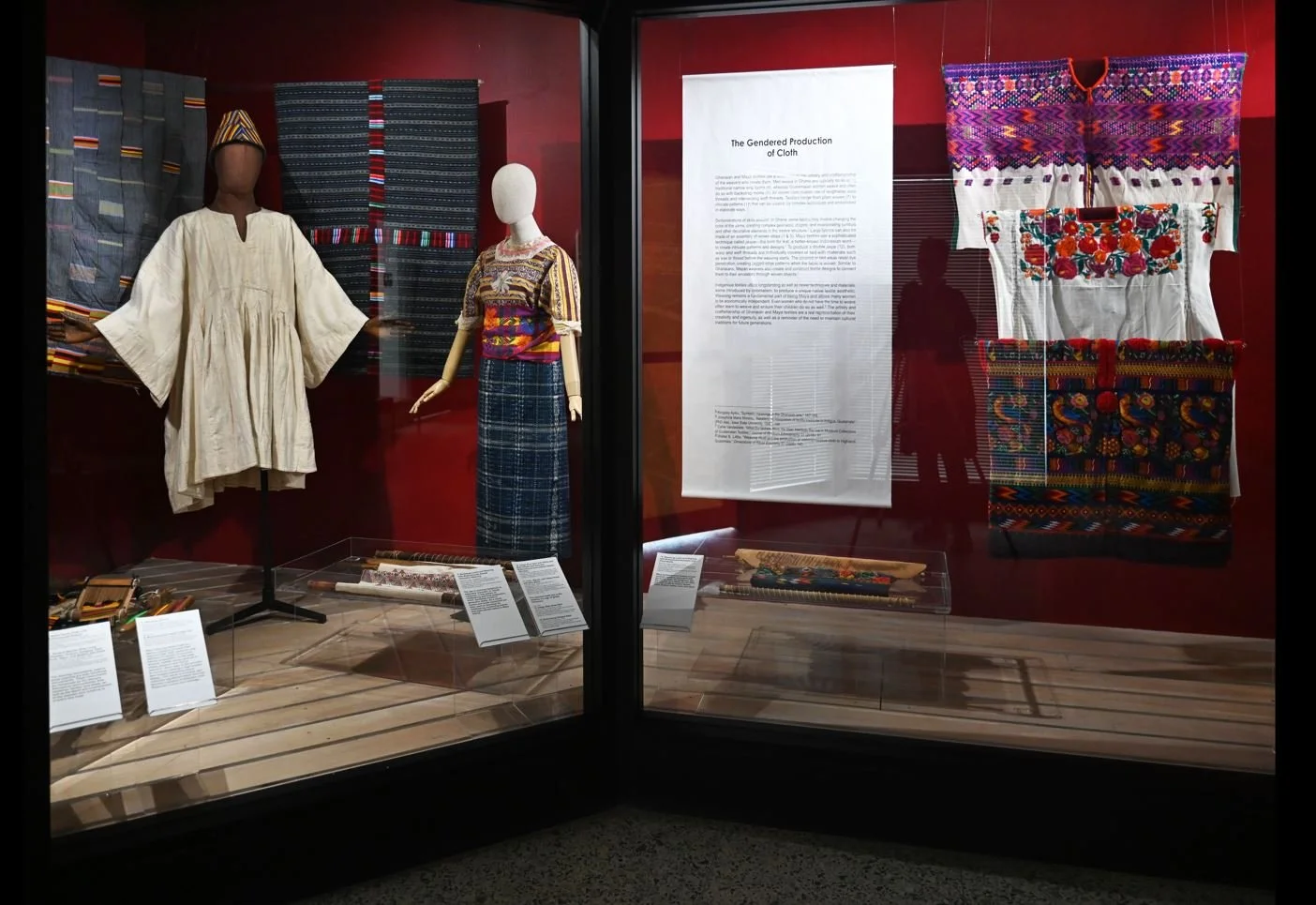Anne Lambert Clothing and Textiles Collection

Weaving Stories and History Together with Textiles
Cover Photo from the Anne Lambert Clothing and Textiles Collection, Human Ecology Department, University of Alberta. All Photos photographed by Anne Bissonnette.
To wrap up our series on places to study fashion in Canada, we’re homing in on a treasure closer to home in Alberta. Among the renowned clothing and textile post-secondary institutions of western Canada shines The University of Alberta’s Human Ecology Program. Offering majors in Clothing, Textiles & Material Culture, with additional avenues in Fashion Business Management, the Human Ecology program boasts a holistic approach to applied education. Alongside its leading programs, the University is set apart as the home for the Anne Lambert Clothing and Textile Collection, located at the heart of the Human Ecology building in Edmonton, Alberta.
Pop-Art poster dress, non-woven pulp and rayon mesh, designed by Harry Gordon, London, 1968 (2009.15.3). Originally sold for $2.50 at The Hudson Bay Company. Anne Lambert Clothing and Textiles Collection, Human Ecology Department, University of Alberta
Unthreading Historical Roots
Founded back in 1972, The Anne Lambert Clothing and Textile Collection is one of the country’s leading collections of fashion and textiles, housing over 23,000 objects of local, national, and international significance.
Stored in a hydraulic-powered library by decade, style and clothing type, the collection consists primarily of clothing, which includes everyday and designer clothing for men, women, and children. With unique pieces originating from different continents, the clothing portion of the collection spans over 350 years’ worth of history. The next largest component includes flat textiles that showcase textile traditions from around the world—from the Rosenberg quilt collection to Ghanaian kente cloth, to hand woven Afghan carpets, and more. Lastly, the collection houses a significant assortment of objects that relate to the production and embellishment of dress and textiles. Examples of this include spindles for making yarn, looms, needlework tools, patterns, historical fashion magazines and photographs.
Robe à la française with petticoat, silk, France (2014.1.1). Anne Lambert Clothing and Textiles Collection, Human Ecology Department, University of Alberta
Wedding ensemble, silk, ca. 1900-05 (1992.3.1). Anne Lambert Clothing and Textiles Collection, Human Ecology Department, University of Alberta
Accepting donation proposals from the community, the Anne Lambert Collection is sustained by pieces of history preserved in and around the community. The detailed approval process for new pieces consists of an expert committee, whose job is to ensure that the objects accepted are not duplicates and fit the collection’s purpose. On occasion, the committee will purchase particular special items to fill clothing gaps in the collection, not likely to be filled through donations:
“We rely on reputable dealers who are transparent and ethical about the pieces they are selling. Much like the art world, historical and rare textiles can be very expensive and are therefore targets for fakes and forgeries.” Katelin Karbonik, Associate Curator at the Anne Lambert Clothing Collection.
Preserving History with Textiles
Dealing with pieces from decades past requires a high level of attentiveness in handling, preservation and care.
“The first and most important part of preservation is proper storage. This might sound a little boring, but it really is critical to the proper care of the objects.”
The Anne Lambert Collection is housed in a purpose-built storage facility in the Human Ecology building, that is temperature and humidity controlled, with limits placed on the amount of light that shines on the objects. Textiles are susceptible to temperature fluctuations, humidity, UV rays, and pests, and can face expedited degradation, the older they are.
Anne Lambert Clothing and Textiles Collection, Human Ecology Department, University of Alberta
Anne Lambert Clothing and Textiles Collection, Human Ecology Department, University of Alberta
Additionally, objects stored in the collection are preserved in a way that protects from deformation and degradation over time.
“When considering long term storage, things like folds and creases should be minimized as much as possible because they can result in permanent damage at the molecular level. We use padded hangers, acid-free tissue paper, and specially constructed mounts to support objects so that they can be preserved for future generations to study and enjoy.”
In terms of physical handling, undergraduate and graduate students are taught the proper handling skills for historical objects, preparing them for jobs in the museum and cultural heritage sector.
“A big part of [learning how to handle historical textiles] is unlearning how we approach objects in our everyday lives. We interact with textiles every day, but the way that we handle our jeans in the morning isn’t necessarily how we want to handle a garment in the collection. Handling is the activity most likely to cause damage to an object, so we really try to slow down and be mindful about it.”
Anne Lambert Clothing and Textiles Collection, Human Ecology Department, University of Alberta
All handlers of textiles in the collection are required to wear clean cotton or nitrile gloves, which protects the pieces from everyday dirt and oils on their hands. Since most items in the collection can not be washed very easily, avoiding soiling altogether is crucial.
Education in Action
The Anne Lambert Collection is first and foremost a teaching collection, meaning its explicit purpose is to be a learning resource for students. Early on, undergraduate students study objects from the collection in a class called Cross-Cultural Textiles, taught by the Collection Manager, Vlada Blinova. More advanced and hands-on courses include graduate and undergraduate classes in museum curatorship, where students collaborate to research, design, and mount an exhibition in the Human Ecology gallery. These courses are often taught by Dr. Anne Bissonnette, Curator at the Anne Lambert Collection.
Other than courses, students can set up appointments to view and spend more time with objects in the collection by emailing the collection manager:
“The evidence is clear: experiential learning is proven to be more effective than other, more traditional learning methods. It’s one thing to say that, but a whole other thing to experience things like a 300-year-old French silk gown or an Indonesian batik, or the colourful Paj Ntaub (flower cloth) embroidery of Hmong women (a southeast Asian indigenous community) up close.”
Studying palpable objects adds a valuable layer of application for students. There's an opportunity for students to direct their own learning and interact with the pieces on a personal level, as each person will notice different things about an object, informed by their interests and past experiences.
Exhibit from the Anne Lambert Clothing and Textiles Collection, Human Ecology Department, University of Alberta
Exhibit from the Anne Lambert Clothing and Textiles Collection, Human Ecology Department, University of Alberta
Visiting the Collection
The best way to support the collection is to use the collection! Appointments to view the Anne Lambert Clothing and Textile Collection can also be requested as members of the public and the larger University community. The collection manager will search the database (which can be accessed publicly through their website) to see what objects match the inquiry. If a match is found, a research appointment with the collection manager is then scheduled. These can often take months to schedule, so it is encouraged to send visit requests well in advance.
The curators and collection staff are constantly in search of items to expand the diversity of textile and textile-related objects in the collection. If you or someone you know has a textile object that they think might fit for the collecting mandate, you can reach out to Dr. Anne Bissonnette at .
The Anne Lambert Collection regularly presents inspired exhibitions in the lobby of the Human Ecology Building that are open to the public during business hours. Most of these exhibits are student-led, with students designing, researching, and mounting the objects themselves.
One to two exhibitions are planned for display every year, with a public opening to kick off the exhibit. Student curators attend to talk about their work with members of the community, while drinks and refreshments are available to all attendees. Currently, the Human Ecology Building is home to an exhibition titled Woven Identities: Ghanaian and Guatemalan Textiles in the Face of Globalization, which will be displayed until March 2024.
Be sure to keep up with updates about the collection (including upcoming exhibitions) on the website!
Hey there, it’s Donnalee - Editor-in-Chief, Founder & Creative Director of The Issue Magazine, the digital fashion magazine in Alberta. Over the past few years, I’ve had the chance to meet and work with so many talented and ambitious entrepreneurs - because of this, I’ve come to love meeting new people and sharing their stories. I hope you’ll join in on this adventure because you’re just as passionate about this as we are - or curious at the least!
| @_donnaalee | https://theissuemagazine.ca/
